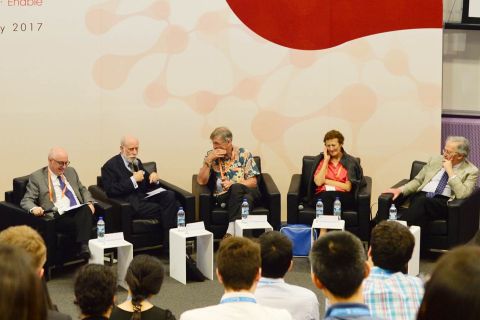
By Rebecca Tan
SMU Office of Research & Tech Transfer – Waiting for a bus and wondering if you have time to grab a coffee before it arrives? If you’re in Singapore, you can easily find out: commuters can pull up a single application on their phones and get arrival timings for any bus service, regardless of which bus company operates it.
This wasn’t always the case - each bus service provider used to operate its own IT system. But the Land Transport Authority subsequently decided that any operator awarded a bus contract would have to use a centralised information system that it would supply.
This gave individual commuters much more useful information about the arrival times of all bus services at a particular stop. The information was also made freely available to app developers, who have since come up with innovative ways of presenting it to users.
“It's an interesting example of how top-down centralisation at one level enables individual agents to get better information for their own lives in a decentralised way. I suspect there will be many more examples of this in the future,” said Singapore Management University (SMU) Vice Provost (Research) Professor Steven Miller, who was moderating a public lecture entitled ‘How Smart Systems Enable More Liveable Cities’, held at SMU on 19 January 2017.
The lecture, organised in conjunction with the Global Young Scientists Summit 2017 (GYSS 2017), featured Mr Tan Kok Yam, Head of Singapore’s Smart Nation Programme Office, and three Turing Award winners, Professor Richard Karp (1985), Professor Butler Lampson (1992) and Dr Vinton Gray Cerf (2004).
The case for centralisation
All four panellists agreed that Internet of Things (IoT) and smart city technology will play an important role in changing the way urban dwellers live, and will have major impacts on transport, housing, the delivery of utilities and even the management of crime. Opinions differed, however, on whether the underlying smart systems architecture of smart cities should be centralised or decentralised.
As illustrated by the example of the bus arrival times, many benefits can arise from the centralisation of people and resources. “Ultimately, the city is a platform,” said Mr Tan. “People come to the city because they want to exchange goods, information and services. So part of being a smart city must be about having platforms to allow these exchanges to be more efficient.”
“As a computer systems designer, my instinct is always to centralise,” added Professor Lampson, who is recognised as the seminal figure in the development of personal computers. “While there are certain situations where you don’t want to have centralisation - because the scale is just too big for example - I don’t believe in this decentralisation ‘religion’.”
Decentralisation to preserve local flavour
For Dr Cerf, currently Chief Internet Evangelist at Google and one of the pioneers of the Internet’s basic communication protocols, centralisation is useful but may not always be required. In the case of a system tracking parking lots, for example, knowing the locations of all parking lots available in a city might be helpful to town planners but may not benefit the driver looking for a lot in a particular garage, he said.
“If the information that’s needed in order to make something liveable is local, it doesn’t need to be centralised in order to make it more effective. I think we shouldn’t get too overwrought about trying to centralise things that are not necessary to centralise,” Dr Cerf said.
Furthermore, although centralised designs may seem more elegant and efficient, they are not necessarily the best way to structure smart cities, said Professor Karp.
“Throughout history there have been many examples of utopian designs for supposedly highly efficient and liveable cities, but most of these tend to lead to a disappointing sterility,” he said, citing the example of Brazil’s capital, Brasília. Designed in the late 1950s by feted Brazilian architect Oscar Niemeyer, Brasília was intended to be a Modernist statement celebrating Brazil’s newfound independence. The result, however, was a city that many found both impractical and dull, lacking the exuberance of the previous capital, Rio de Janeiro.
“Very likely, the successful design of a smart city will not be a global design, but a design which deals with local areas, with the consent and participation of residents in those areas. This design should not only foster efficiency in a narrow engineering sense, but should also take into account the very important goal of fostering connection,” Professor Karp continued.
Meeting in the middle
In the real world, smart city systems are likely to be a blend of both centralised and decentralised architecture, Professor Lampson said.
“Suppose you want to build an intelligent traffic light. It’s going to have cameras that look at oncoming traffic, it’s going to talk to all the neighbouring traffic lights and the city bus coordination system and so on. It’s going to be 20 million lines of code… and it’s going to be full of bugs,” he quipped.
However, if this smart traffic light is connected to another component which enforces two simple rules - at least one direction of traffic is always red, and if the light turns yellow it stays yellow for at least three seconds - then it would work very well, Professor Lampson continued.
“I think Butler’s [Professor Lampson’s] suggestion of separating the safety requirement from the requirement of optimal behaviour is a very good approach because the safety requirement can be formulated very simply and limits the possibility of error,” Professor Karp said.
The panellists gave a variety of contrasting examples to show how emerging smart systems and smart city technologies will simultaneously lead to new types of highly centralised systems, as well as to deeply personalised and localised systems. Age-old design dilemmas between centralisation and decentralisation, it seems, will continue to be cutting-edge issues as countries move forward with smart systems and their deployment in the context of smart cities.
Back to Research@SMU Issue 43
See More News
Want to see more of SMU Research?
Sign up for Research@SMU e-newslettter to know more about our research and research-related events!
If you would like to remove yourself from all our mailing list, please visit https://eservices.smu.edu.sg/internet/DNC/Default.aspx

